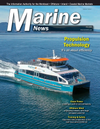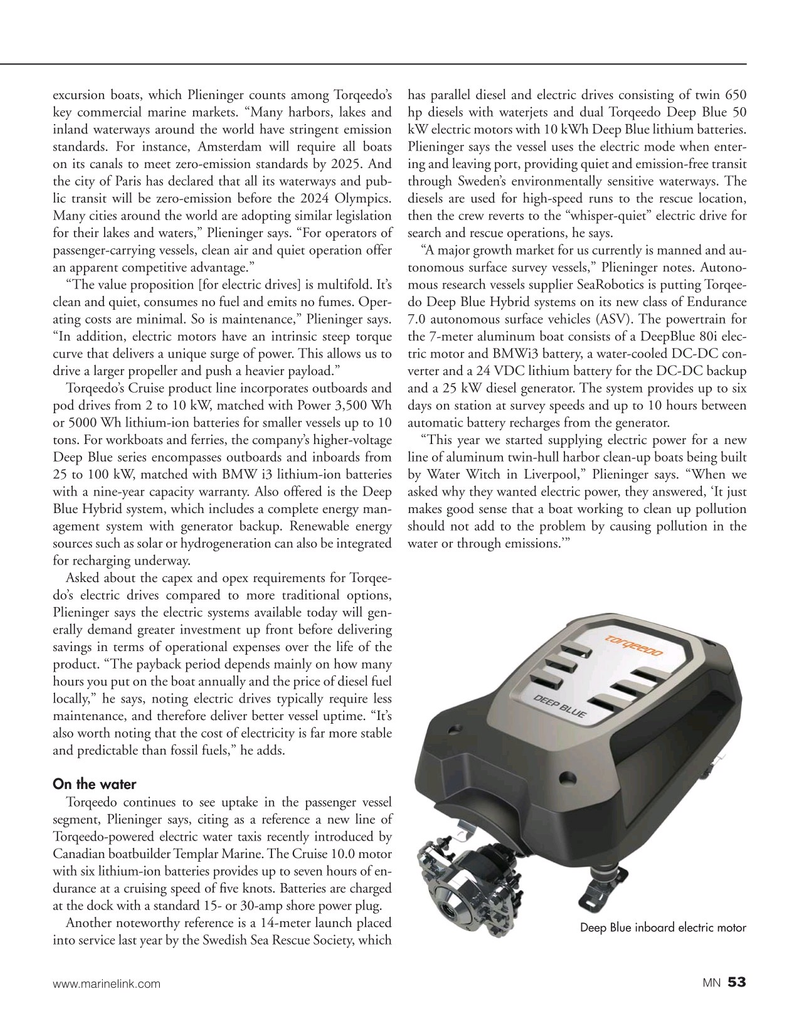
Page 53: of Marine News Magazine (July 2020)
Propulsion Technology
Read this page in Pdf, Flash or Html5 edition of July 2020 Marine News Magazine
excursion boats, which Plieninger counts among Torqeedo’s has parallel diesel and electric drives consisting of twin 650 key commercial marine markets. “Many harbors, lakes and hp diesels with waterjets and dual Torqeedo Deep Blue 50 inland waterways around the world have stringent emission kW electric motors with 10 kWh Deep Blue lithium batteries. standards. For instance, Amsterdam will require all boats Plieninger says the vessel uses the electric mode when enter- on its canals to meet zero-emission standards by 2025. And ing and leaving port, providing quiet and emission-free transit the city of Paris has declared that all its waterways and pub- through Sweden’s environmentally sensitive waterways. The lic transit will be zero-emission before the 2024 Olympics. diesels are used for high-speed runs to the rescue location,
Many cities around the world are adopting similar legislation then the crew reverts to the “whisper-quiet” electric drive for for their lakes and waters,” Plieninger says. “For operators of search and rescue operations, he says.
passenger-carrying vessels, clean air and quiet operation offer “A major growth market for us currently is manned and au- an apparent competitive advantage.” tonomous surface survey vessels,” Plieninger notes. Autono- “The value proposition [for electric drives] is multifold. It’s mous research vessels supplier SeaRobotics is putting Torqee- clean and quiet, consumes no fuel and emits no fumes. Oper- do Deep Blue Hybrid systems on its new class of Endurance ating costs are minimal. So is maintenance,” Plieninger says. 7.0 autonomous surface vehicles (ASV). The powertrain for “In addition, electric motors have an intrinsic steep torque the 7-meter aluminum boat consists of a DeepBlue 80i elec- curve that delivers a unique surge of power. This allows us to tric motor and BMWi3 battery, a water-cooled DC-DC con- drive a larger propeller and push a heavier payload.” verter and a 24 VDC lithium battery for the DC-DC backup
Torqeedo’s Cruise product line incorporates outboards and and a 25 kW diesel generator. The system provides up to six pod drives from 2 to 10 kW, matched with Power 3,500 Wh days on station at survey speeds and up to 10 hours between or 5000 Wh lithium-ion batteries for smaller vessels up to 10 automatic battery recharges from the generator.
tons. For workboats and ferries, the company’s higher-voltage “This year we started supplying electric power for a new
Deep Blue series encompasses outboards and inboards from line of aluminum twin-hull harbor clean-up boats being built 25 to 100 kW, matched with BMW i3 lithium-ion batteries by Water Witch in Liverpool,” Plieninger says. “When we with a nine-year capacity warranty. Also offered is the Deep asked why they wanted electric power, they answered, ‘It just
Blue Hybrid system, which includes a complete energy man- makes good sense that a boat working to clean up pollution agement system with generator backup. Renewable energy should not add to the problem by causing pollution in the sources such as solar or hydrogeneration can also be integrated water or through emissions.’” for recharging underway.
Asked about the capex and opex requirements for Torqee- do’s electric drives compared to more traditional options,
Plieninger says the electric systems available today will gen- erally demand greater investment up front before delivering savings in terms of operational expenses over the life of the product. “The payback period depends mainly on how many hours you put on the boat annually and the price of diesel fuel locally,” he says, noting electric drives typically require less maintenance, and therefore deliver better vessel uptime. “It’s also worth noting that the cost of electricity is far more stable and predictable than fossil fuels,” he adds.
On the water
Torqeedo continues to see uptake in the passenger vessel segment, Plieninger says, citing as a reference a new line of
Torqeedo-powered electric water taxis recently introduced by
Canadian boatbuilder Templar Marine. The Cruise 10.0 motor with six lithium-ion batteries provides up to seven hours of en- durance at a cruising speed of ?ve knots. Batteries are charged at the dock with a standard 15- or 30-amp shore power plug.
Another noteworthy reference is a 14-meter launch placed
Deep Blue inboard electric motor into service last year by the Swedish Sea Rescue Society, which 53 www.marinelink.com MN

 52
52

 54
54
